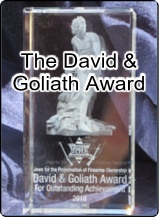

America's Secretest Weapon
By L. Neil Smith, lneil@netzero.com. The Libertarian Enterprise
© Copyright JPFO. Inc
 The object in this photograph, just short of an inch long in real life, is a round of small-arms ammunition known as ".22 Long Rifle", mostly for historical reasons, It works perfectly in hundreds of different kinds of pistols and revolvers, as well. It is a puny thing, relatively speaking, compared to other popular rifle and pistol cartridges.
The object in this photograph, just short of an inch long in real life, is a round of small-arms ammunition known as ".22 Long Rifle", mostly for historical reasons, It works perfectly in hundreds of different kinds of pistols and revolvers, as well. It is a puny thing, relatively speaking, compared to other popular rifle and pistol cartridges.
The ubiquitous 9 millimeter pistol cartridge is good for roughly 350 foot/pounds of energy, which is how these things are measured. The .45 ACP (Automatic Colt Pistol), which many individuals regard as the most reliable self-defense cartridge ever invented, creates about 400 foot/pounds. Dirty Harry's mighty .44 Magnum can produce about 1000 foot/pounds. .223 Winchester, the nasty little cartridge fired by the nastly little M-16, produces 1465 foot/pounds. 7.62x39mm, the AK-47 and SKS round yields 1650 foot/pounds. .30-06, the cartridge employed in both World Wars, generates just short of a ton and a half: 2997 foot/pounds.
.22 Long Rifle produces 102.
Nevertheless, Robert F. Kennedy was shot to death using at least one revolver loaded with .22 Long Rifle cartridges, and Sarah Brady's meat-puppet husband James was turned by the same caliber of cartridge into the poster boy for punishing every American who didn't shoot him, just as Gabby Giffords wants to punish everybody who didn't shoot her.
People use .22 Long Rifle for a variety of purposes. It's common to hunt rabbits and squirrels with it, and it has fed many a hungry family. It's possible to kill a deer with it, but illegal in most states. Many individuals somewhat foolishly rely on it for last-ditch self-defense.
 But more than anything else, .22 Long Rifle is used for practice, competition, and recreation. The fundamentals of firearms use can be learned cheaply using this little cartridge, which costs the merest fraction of what larger, high-performing cartridges cost. Almost every grownup shooter I know began with a .22 of some description. Mine was a big, heavy bolt-action single-shot Winchester Model 52, belonging to the club that ran the range. It weighed nine pounds, like a wagon-axle on a fencepost, and involved more straps and buckles than a fetish video.
But more than anything else, .22 Long Rifle is used for practice, competition, and recreation. The fundamentals of firearms use can be learned cheaply using this little cartridge, which costs the merest fraction of what larger, high-performing cartridges cost. Almost every grownup shooter I know began with a .22 of some description. Mine was a big, heavy bolt-action single-shot Winchester Model 52, belonging to the club that ran the range. It weighed nine pounds, like a wagon-axle on a fencepost, and involved more straps and buckles than a fetish video.
I was an undersized 11-year-old, shooting in the basement of an Air Force base building, for a merit badge and sharpshooter's medal under sponsorship of the Boy Scouts of America and the National Rifle Association.
"Postal matches" were conducted there, and I was involved somehow, but can't remember the details. I wasn't a good shot: I couldn't hold the gun up long enough to form a sight picture. One Saturday morning, I went in to make up a match I'd missed the previous week and had a religious experience: a kid there was shooting a tiny semiautomatic Browning .22 with a receiver about the size of a flashlight battery. It was lightweight -- 5 pounds -- and handy, with an 11-round tubular magazine in the butt-*stock. I shot the best score with it I'd ever shot.
But as usual, I have digressed.
 The .22 Long Rifle cartridge is probably used most -- far more than any other cartridge -- for the kind of informal target practice called "plinking": shooting empty cans, plastic bottles, and so on. There are very few things in life that I have found more satisfying. Of course, every shot you fire, even in this loose, easy way, makes for valuable practice. Most of what I know about shooting I learned from .22 Long Rifle.
The .22 Long Rifle cartridge is probably used most -- far more than any other cartridge -- for the kind of informal target practice called "plinking": shooting empty cans, plastic bottles, and so on. There are very few things in life that I have found more satisfying. Of course, every shot you fire, even in this loose, easy way, makes for valuable practice. Most of what I know about shooting I learned from .22 Long Rifle.
Which brings us to the point I want to make. I read the other day that Mike Vanderbough*, a man I admire greatly, has said that, with millions of deer hunters in the field every fall, using high-powered, telescopically-sighted rifles, the American corps of snipers is larger than entire armies of other countries, including our own. Given the grade of firearms training offered by most governments, any invaders dumb enough to pick on us are in for the military nightmare of their lives.
Now it's easy enough to drop the hammer on a mule deer. I've done it many times, myself. But my guess is that it's different doing it to another human being, even one wearing a sky-blue helmet, Still, Mike's made a point I never thought of; he's almost certainly right. What did Admiral Yamamoto say about "a rifleman behind every blade of grass"? That was his description of America, and why he didn't want to fight us.
Taking nothing at all from Mike, here's another statistic that ought to raise the hair on the back of the neck of every potential troublemaker with an IQ bigger than his shoe size: the historically important fact about the humble .22 Long Rifle is that Americans shoot two billion rounds of the stuff every year. That's 11 million pounds of lead -- 5700 tons -- poured downrange every year, 40 grains at a time.
A grain (Avoirdupois) is 1/7000 of a pound.
Two billion rounds.
 What sort of fool would deliberately get into a dust-up against a population with that kind of firepower and hands-on experience? Who would contemplate sending minions into what amounts to a solid lead wall, moving at a thousand feet per second? Apparently, the fools at the United Nations and their hangers-on and enablers, who mistakenly believe they won't be the poor slobs sent out there to the downrange side of 80 or 100 million American shooters, grimly determined to preserve their political independence, individual freedom, and their guns.
What sort of fool would deliberately get into a dust-up against a population with that kind of firepower and hands-on experience? Who would contemplate sending minions into what amounts to a solid lead wall, moving at a thousand feet per second? Apparently, the fools at the United Nations and their hangers-on and enablers, who mistakenly believe they won't be the poor slobs sent out there to the downrange side of 80 or 100 million American shooters, grimly determined to preserve their political independence, individual freedom, and their guns.
Two billion rounds.
And every one, if we make it so, a shot heard 'round the world.
===============
*http://sipseystreetirregulars.blogspot.com/
![]()
A fifty-year veteran of the libertarian movement, L. Neil Smith is the Author of 33 books including The Probability Broach, Ceres, Sweeter Than Wine, And Down With Power: libertarian Policy In A Time Of Crisis. He is also the Publisher of The Libertarian Enterprise, now in its 17th year online.
Visit the Neil Smith archive on JPFO.
© Copyright Jews for the Preservation of Firearms Ownership 2013.
![]()



































